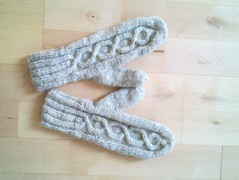In an earlier blog post (
Stress test for handspun yarn), I tested how different yarn structures handle stress. This is a continuation of the earlier experiment, because while it's interesting to know how heavy shopping bags you can hang from wool yarn, it's also interesting to see how wool handles abuse under stress.
All photos are clickable for a bigger version with more detail; measurements are in metric.
Test set-up The equipment
The equipmentThe highly scientific and extremely rigorous test set-up consisted of two S-hooks, a cloth shopping bag, and paperback books plus packets of instant oatmeal (for weights). I tested the yarns by tying a certain length of yarn to the hooks, and then hanging the hook on one end to the bar for hanging coats in the hallway, and suspending the bag from the hook tied to the other end. Then I increased the load by adding books/oatmeal (or applied abrasion) until the yarn broke.
 String heddles for abrasion test, singles of yarn used in testing
String heddles for abrasion test, singles of yarn used in testingSome notes about the yarn used for the tests:
Fibre: 100% merino wool, commercial top
Tool: Spun with a wheel, plied with a Bosworth mini spindle
Drafting method: short draw across the top
Twist direction: Z-spun singles, all yarns S-plied
Type: worsted
Notes: The twist angle is not completely consistent, since I scavenged extra singles and remnants of a 3-ply
sock yarn, and for some samples had to unply and re-ply to get enough material. This may have skewed the results for some experiments.
I first tested how much weight would be needed to break one singles of the yarn. This turned out to be ca. 640 g (22.5 oz). After determining that, I tensioned the length of yarn to be tested with a bag full of books and oatmeal packets weighing the aforementioned ca. 640 g (22.5 oz) and repeatedly pulled a cotton string tied in the shape of a heddle over a 10-20 cm section (4-9 in), at the same time pulling the yarn about 5-10 cm (2 in) to one side from the straight line, and counted how many times I could move the heddle into one direction (up or down) before the yarn broke.
Side note: wool, especially worsted-spun wool, is stronger than you'd think. It ate through my string heddles (as you can see), and I had to repair them several times. And this is rug warp for rag rugs - the same stuff that carves deep grooves in the wood beams of the loom.
Yarn breaking in numbers and picturesIntact yarnsBaseline:
Singles - intact
Breaking from weight alone: 642 g (not pictured)

2-ply - intact
Breaking from weight alone: 1472 g

Chain ply (1) - intact
Breaking from weight alone: 3016 g

3-ply (1) - intact
Breaking from weight alone: 2306 g

Chain ply (1) - intact
Abrasion at the knot: 219 passes (2nd try: 263 passes; not pictured)

3-ply (1) - intact
Abrasion: 464 passes (1st try: 76 passes; yarn not comparable with significantly softer twist; not pictured)
One strand cut
3-ply - 1 strand cut
Abrasion: 69 passes

Chain ply - 1 strand belonging to the “straight line” in the knot cut at a distance of ca. 3 cm from the knot
Abrasion at the knot: 56 passes

Chain ply - 1 strand belonging to a loop in the knot cut at a distance of 7 cm from the knot
Abrasion at the knot: 3 passes
ThoughtsChain ply and 3-ply are
structurally different, but in many situations they are just as strong. However, while parts of 3-ply and chain ply are identical, the knot in chain ply has interesting behaviour. When any of the strands forming the two locked loops in the knot is broken close enough to the knot that friction can’t stop the loop from slipping open, the end result is only one intact singles at that particular point, so the yarn behaves as a singles yarn. But if the “straight line” strand is broken, the locked loop is intact and behaves comparably to a 2-ply (a 3-ply with one strand cut becomes a 2-ply at that spot).
Sounds scary? Well, even in weaving, where the real life (i.e. yarn under tension and abrasion from heddles) more closely follows my experiment, you may not run into any problems. After all, with the yarns I hadn't deliberately and maliciously sabotaged, it took literally hundreds of passes before the yarn broke, causing it to become fuzzy and visibly worn long before it broke. Also, I found that with wool, twist energy and the friction between the plies kept the yarn hanging together for a good long time even when a strand broke. Fibre and spinning can also make a difference - if you look at the results in the earlier
blog post, the thinner woollen-spun yarn was significantly weaker. Someday, I may repeat this experiment with silk, to see what happens if you use a slipperier fibre...
So, what does that mean for practical purposes? Nothing much. In normal wear, I'd have no qualms making socks out of chain ply, let alone a whole sweater that faces much less abuse. Even if a weak spot snagged at a nail and the yarn broke, well, who's to say that the same thing wouldn't happen to a 3-ply?
But there can be some circumstances where the properties of chain ply vs. 3-ply can make a difference. As my sample size was small, the results changed significantly with the type of yarn used, and special circumstances are, well, special (such as weaving a thin silk scarf with a backstrap loom, or knitting a tablecloth-sized wedding ring shawl from whisper-thin frog hair you're planning to stretch and block aggressively) - if you're worried, it's best if you do a sample of your own first.




















































